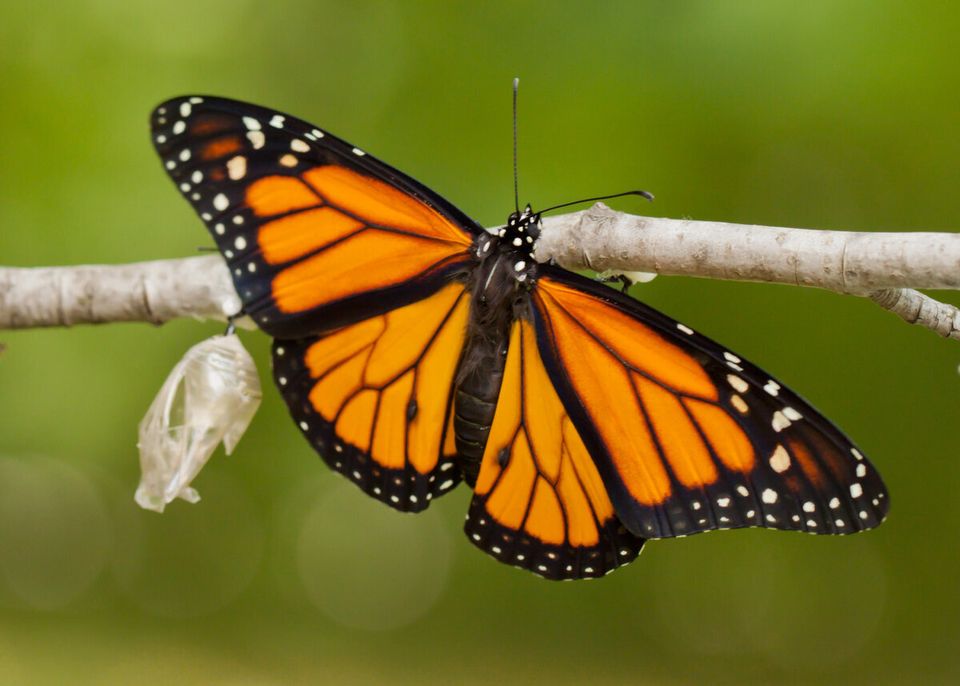
Jode Roberts has spent a lot of the summer checking out ditches and fields along the sides of roads, railways and trails. At first, he didn't like what he was seeing. Roberts, who is leading the David Suzuki Foundation's effort to bring monarchs back from the brink, was searching for signs that the butterflies had visited patches of milkweed plants. Despite the bleak start, he recently hit the jackpot: a half-dozen eggs and a couple of monarch caterpillars, calmly munching on milkweed leaves.
Over the past millennium, eastern monarch butterflies have migrated northward from Mexico in spring, arriving in southern Ontario, Quebec and the Maritimes in early summer, where they lay eggs on the undersides of milkweed leaves. In the following weeks, their caterpillars hatch and eat a steady milkweed diet. In late summer, they form chrysalises and undergo the amazing transformation into butterflies. They then begin fattening themselves for the arduous return to the Mexican alpine forests where they overwinter.
Concerned citizens, scientists and conservation groups were starting to think monarchs might largely be a no-show in Canada this summer. The eastern monarch population has plummeted from more than a billion butterflies in the 1990s to an estimated 35 million in 2014 -- a drop of more than 95 per cent. They bounced back to about 55 million in Mexico this past winter, but a cool start to their journey northward coupled with the virtual eradication of milkweed plants -- mainly thorough widespread use of the herbicide glyphosate (Roundup) over the past two decades -- left monarch experts wondering whether the butterflies would make it across the border this year.
The good news is that citizen scientists and backyard butterfly lovers from across the northeastern U.S. and southern Canada have reported through social media that monarch butterflies are arriving and laying a remarkable number of eggs. But it's too early to gauge whether the numbers will meet already low expectations.
While monarch enthusiasts are breathing a momentary sigh of relief, Roberts and colleagues have launched the Monarch Manifesto, encouraging people throughout the monarchs' path to pledge to do their part to ensure the butterflies continue to recover. Visit davidsuzuki.org/monarchmanifesto to sign.
Participants are asked to commit to do three simple things this summer: grow milkweed, report monarch sightings and avoid using pesticides on their properties. They also commit to two simple tasks for the fall: reach out to at least one neighbourhood school, faith group, business or other institution about planting a butterfly garden and call local garden centres or nurseries to ask them to order native milkweed plants for next spring. Manifesto signatories will receive information and tips on how to begin these conversations.
The Monarch Manifesto is part of a growing movement to bring back monarch butterflies and help other important pollinators, like honeybees and wild bees. If all goes well, we'll see thousands of participants, hundreds of new butterfly gardens and more local milkweed sources next spring.
The backyard and urban-focused campaign is bolstered by research by University of Delaware entomologist Douglas Tallamy, who found monarchs lay more eggs on garden plants than on milkweed in meadows. The campaign also complements a research project the David Suzuki Foundation will launch this fall, in partnership with University of Guelph researchers Tyler Flockhart and Ryan Norris, examining best practices for cultivating milkweed and encouraging monarch populations along rail and hydro lines, roadways and trails.
What can you do to help? An easy first step is to sign the Monarch Manifesto, which includes information on how to attract butterflies to your neighbourhood. If you already have milkweed in your garden or on your balcony, consider collecting seeds this fall and sharing them with friends and neighbours. If you don't have a garden or balcony, you can look for places where you live, work and play that could become new butterfly garden patches.
While Roberts continues his hopeful hunt for signs of monarchs this summer, I hope you'll join thousands of people who are taking action, adding pollinator-friendly plants to their yards, spurring butterfly gardens in their neighbourhoods and transforming a multitude of spaces into safe havens for bees and butterflies. Together, we can bring monarch butterflies back from the brink.
Written with contributions from David Suzuki Foundation Homegrown National Park Project Manager Jode Roberts.
Learn more at www.davidsuzuki.org.
ALSO ON HUFFPOST:
